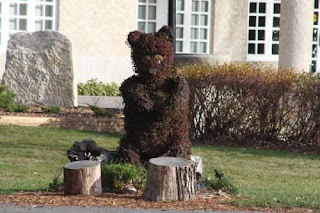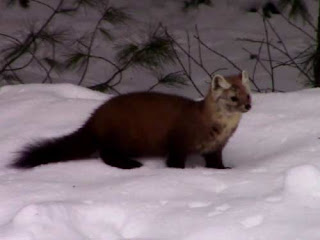Location: Algonquin Park, Ontario, Canada
Address: Spruce Bog Trail
Date: Feb 2019
Website: www.algonquinpark.on.ca
While Algonquin Park is known for moose and bears and wolves, in the winter it is all about the little guys. We visited the Ontario provincial park with a goal to try and see one little critter who is quite active during the winter months. We were on the trail of the American Pine Marten.
We started our search on the Spruce Bog Trail as there had been reports of marten spotted here. A chickadee welcomed us as we started the trail. Things looked promising.
We came across some small tracks in the snow. Things looked even more promising. We are not the best at identifying tracks, but we believe we have marten tracks in the photo above.
Next we were greeted by one of the guardians of the forest. A grey jay flew to a nearby branch to watch us on our hike. "Can you show us where the pine marten are hiding?" we asked. The grey jay flew from branch to branch in front of us leading the way. After a short time he flew off. We didn't come across any marten, but we always enjoy a visit from a curious jay all fluffed up for winter.
As we were scanning the snow looking for marten tracks we noticed something unexpected walking across the snow. It was a snow fly. We never expected to see insects during the winter months, but that is when the adult snow flies live. They have glycerol inside them to prevent their bodies from freezing in the cold weather.
When we returned to the parking lot after our hike, we learned that we had just missed a pair of pine marten running around in the snow at the edge of the lot. While we had been out on the trail they had been putting on a show. We hung around for a little while just in case. Still we had no luck and decided to see what was going on at the Visitor Centre.
At the back of the Algonquin Visitor Centre is a large viewing area that looks out across the valley below. We noticed a group of photographers interested in something in the distance. In the center of the photo above is a porcupine at the top of a tree (trust us). Unfortunately, there are not too many porcupine in Algonquin. They are preyed upon by the slightly larger relative of the pine marten, the fisher. Fishers themselves are a rare sighting in the park.
There is also a bird feeder behind the Visitor Centre which sometimes attracts martens looking to eat some of the bird seeds. It never disappoints as various birds come and go. A common redpoll (above) is one frequent winter visitor.
Another bird we had never seen before is the pine grosbeak. The male is the brighter red coloured one. We had seen a lot of different things today, but it was still the martens we had our sights on.
We had one last place we wanted to try in our search for the marten. We headed to Mew Lake Campground where there is an old airfield and of course camping.
No sooner had we pulled the car into a parking spot when we spotted something in the rear-view mirror. At last! A pine marten had just climbed over the snow bank and onto the road.
We stepped out of the car and the marten ran back into the woods. We stayed still and it wasn't long until the marten showed itself again and continued searching through the snow. A marten is about the size of a small cat but with much shorter legs.
After spending some time with our new forest friend, we started to head back to our car. We noticed something that looked like pepper in the snow. Upon closer examination we realized it was snow fleas or springtails. Another winter insect. As we watched them we could see the fleas hop off the snow and disappear into the air.
Suddenly, something flew near us and at first we thought it was a moth. We had seen enough insects that day, why not a snow moth? Something else flew towards us and we realized it was a group of chickadees. They took turns swooping in and landing or almost landing on us. They must have thought we wanted to feed them. As they flew closer to our faces, we decided to take cover and call it a day. It truly was a day full of small creatures, but the marten was definitely the cutest animal in the forest that day, or some might say any day.
Map of Our World
 Algonquin Park (Mew Lake)
Algonquin Park (Mew Lake) ,
Algonquin Park (Spruce Bog)
Post # 297
 Nature Playground ,
Red River Ox Cart
Nature Playground ,
Red River Ox Cart  The Pavilion At Assiniboine Park
The Pavilion At Assiniboine Park 


































